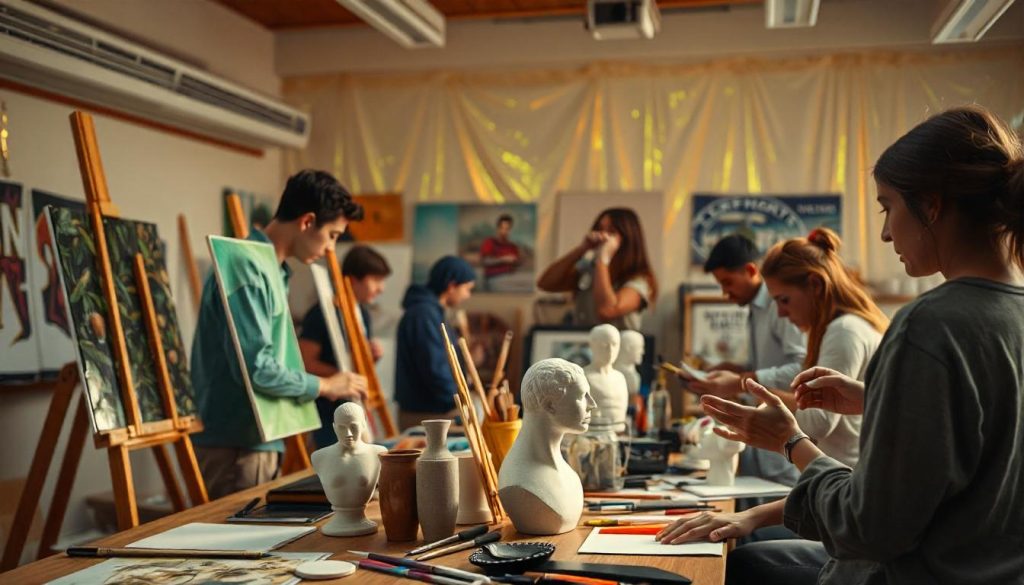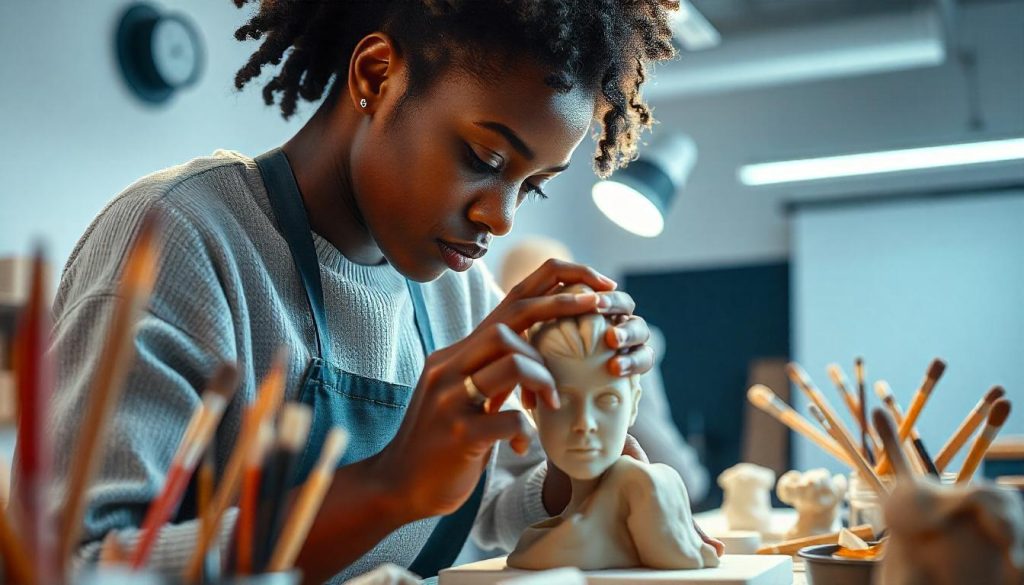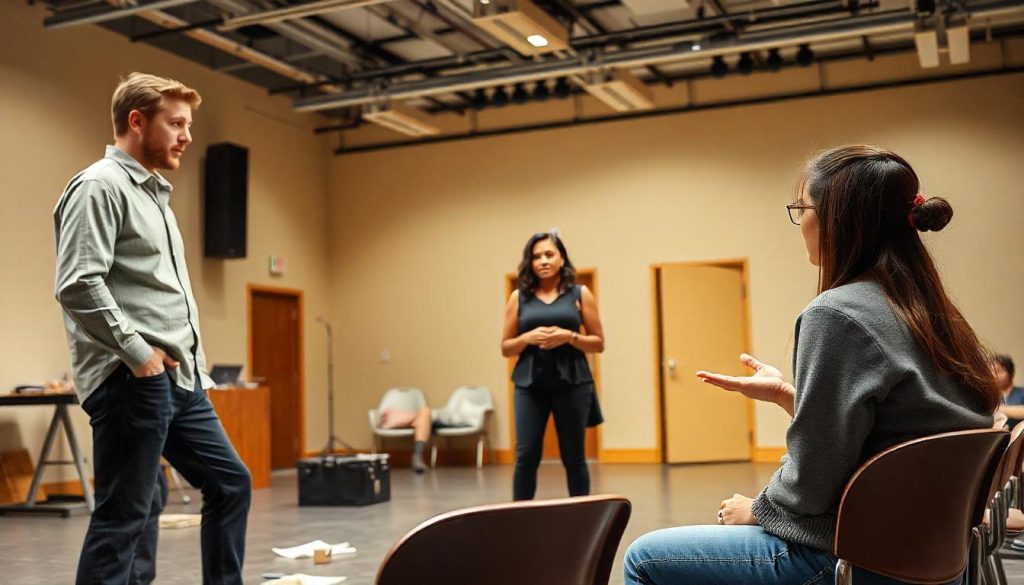List Of All Courses Under Art Department In University
Table of Contents
Introduction
Ever wondered about courses under art department in university?
As an art student, it’s a world of creativity and self-expression. You’ll find everything from painting to performing arts. The art department is where imagination meets skill.
It’s not just about drawing or acting. It’s about exploring humanity, history, and the stories that shape our world. Sounds exciting, doesn’t it?
In this article, we’ll explore the art department. You’ll see a detailed list of all courses under art department and how they’re categorized. From fine arts to performing arts, and even liberal arts education, we’ve got you covered.
We’ll look at what makes these courses unique. You’ll learn how they can shape your career and why they’re essential today. Whether you’re into visual arts specialization, passionate about creative arts programs, or curious about humanities and social sciences, you’re in the right place.
So, grab your sketchpad, tune your guitar, or just sit back and read on. Let’s unravel the magic behind the art department and explore the endless possibilities it offers!

Understanding the Art Department
Let’s start with the basics. What exactly is the art department in a university?
It’s the creative heartbeat of the campus. Students dive into humanities and social sciences, explore their talents, and turn ideas into masterpieces. The art department isn’t just about making art—it’s about learning how art connects with culture, history, and even technology.
Imagine walking into a space buzzing with creativity. One room might be full of students sketching their visions, while another has actors rehearsing powerful scenes. Across the hall, someone’s composing music, and next door, a debate about the philosophy of art is happening. That’s the beauty of the art department—it’s a blend of skills, knowledge, and passion.
What Does the Art Department Offer?
The art department typically focuses on four key areas:
| Category | What It Covers | Example Courses |
|---|---|---|
| Fine Arts | Painting, sculpture, drawing, and other hands-on art forms. | Drawing Techniques, Sculpture 101 |
| Performing Arts | Dance, music, theater, and everything related to performance. | Theater Basics, Contemporary Dance |
| Visual Arts | Digital media, photography, and graphic design. | Digital Photography, Visual Storytelling |
| Liberal Arts Education | Subjects blending art with history, literature, and philosophy. | History of Art, Philosophy of Aesthetics |
Why Is It Important?
The art department plays a vital role in shaping well-rounded individuals. It teaches you to think critically, express creatively, and understand the world in a deeper way. Whether you’re pursuing courses under art department in university or curious about all courses under art department, the skills you learn here will stay with you forever.

Stay tuned because we’re diving into the categories of courses and what each offers. Whether you’re an aspiring artist or just exploring, you’ll love what’s coming next!
Categories of Courses in the Art Department
Let’s break down the types of courses under art department in university into categories. Each area is unique and offers something special. Whether you’re into painting, performing, or studying the connection between art and history, there’s a perfect fit for you!
A. Fine Arts Degree
This is what most people imagine when they think of art. It’s hands-on and all about creating. Fine arts courses focus on painting, drawing, sculpture, and more.
What’s in a Fine Arts Degree?
- Painting: Learn about color theory, techniques, and creating expressive works.
- Sculpture: Work with clay, wood, or metal to bring your ideas to life.
- Drawing: Master basic sketches to intricately designed works.
Why It’s Amazing:
Fine arts let you turn your imagination into something tangible. You’ll get messy (in a fun way!) and create work that inspires others. Plus, it’s a solid foundation for careers in design, illustration, and even animation.

B. Liberal Arts Education
This one’s a blend of art and academics. It combines the best of humanities and social sciences with a creative twist.
Key Courses:
- Art History: Dive into how art evolved over centuries and influenced society.
- Philosophy of Art: Explore deep questions like “What is beauty?” or “Why do we create?”
- Cultural Studies: Study the connection between art and culture.
Why It’s Important:
These courses help you see the big picture. You’ll learn to analyze art, understand its impact, and even relate it to other fields like sociology or anthropology.
| Course | What You’ll Learn |
|---|---|
| Art History | The stories behind famous artworks and movements. |
| Philosophy of Art | Theories about the purpose and value of art. |
| Cultural Studies | How art reflects and shapes cultural identity. |
C. Performing Arts Studies
Are you drawn to the stage? Performing arts courses let you shine. Whether it’s acting, music, or dance, these courses are all about expressing yourself.
Popular Courses:
- Theater Basics: Learn acting techniques, voice modulation, and stage presence.
- Music Composition: Write and perform original music.
- Dance Choreography: Master movement and storytelling through dance.
Career Opportunities:
- Actors and directors in theater or film.
- Musicians in orchestras or bands.
- Choreographers or dancers in major productions.

Stay tuned because next, we’ll explore visual arts specialization, creative arts programs, and how these courses shape modern careers.
Detailed List of All Courses Under Art Department
Now that we’ve covered the categories, let’s dive into a detailed list of all courses under art department that universities typically offer. This list gives you a clear idea of what to expect.
| Category | Courses Offered |
|---|---|
| Fine Arts | Painting, Sculpture, Drawing, Ceramics, Printmaking |
| Performing Arts | Acting, Music Composition, Dance, Stage Production |
| Visual Arts | Photography, Graphic Design, Animation, Digital Media |
| Creative Arts Programs | Creative Writing, Film Studies, Media Arts |
| Liberal Arts | Art History, Philosophy of Art, Cultural Studies |
Universities often customize their programs, so you’ll find a mix of traditional and modern courses. Whether you’re into visual arts specialization or want to blend arts with academics, there’s something for you.

Want to know how these courses translate into real-world careers? Stick around, because that’s coming up next!
Career Prospects for Art Department Graduates
So, you’re thinking about taking courses under art department in university, but you might be wondering—what’s next? Let’s talk about where an arts degree can take you. Spoiler: The possibilities are endless!
1. Fine Arts Careers
If you’ve specialized in fine arts, your creative skills can land you roles in:
- Illustration: Work for magazines, books, or even create digital illustrations.
- Gallery Artist: Exhibit your work in galleries and art fairs.
- Art Restoration: Help preserve historical artwork.
Fun Fact: Many fine artists also teach their craft, either privately or in schools. This way, you can pass on your skills while creating your own masterpieces!
2. Performing Arts Careers
Love being in the spotlight? The performing arts open doors to exciting careers like:
- Actor: Star in theater, films, or television.
- Musician: Perform in orchestras, bands, or as a solo artist.
- Choreographer: Design dance routines for stage shows, music videos, or events.
Performing arts courses don’t just train you for creative roles. They also teach leadership, confidence, and public speaking—skills you can use in any career.
3. Visual Arts Careers
For those passionate about visual arts specialization, technology and creativity combine for roles such as:
- Graphic Designer: Create logos, websites, and promotional materials.
- Animator: Work in the entertainment industry to bring characters to life.
- Photographer: Specialize in events, fashion, or wildlife photography.
In today’s digital world, visual artists are in high demand. From advertising to social media, your skills can make an impact.
4. Liberal Arts Careers
A background in liberal arts education prepares you for roles beyond traditional art fields:
- Art Historian: Work in museums, galleries, or academic institutions.
- Cultural Analyst: Study how art influences society and trends.
- Writer/Editor: Combine your love for words and art to create engaging content.
5. Creative Arts Careers
Graduates from creative arts programs find opportunities in industries like:
- Film and Media Production: Be a part of storytelling through movies and documentaries.
- Creative Writing: Publish books, write scripts, or create compelling blogs.
- Game Design: Collaborate with developers to create visually stunning video games.
Why Art Graduates Stand Out
Art department graduates can think outside the box. Employers value creativity and problem-solving. Your art skills give you an edge in any field.
Feeling inspired? Up next, let’s look at why taking courses under art department in university is so beneficial—not just for your career but for personal growth too!
Benefits of Taking Courses Under Art Department in University
You might be wondering, “Why choose a course in the art department?” It’s not just about gaining knowledge; it’s about shaping who you are. Here’s why enrolling in courses under art department in university is a game-changer.
1. Develop Creative Thinking
The art department encourages you to think differently. Whether you’re brainstorming for a painting or designing a performance, creativity becomes second nature. This skill isn’t just for artists—it’s highly valued in any career.
2. Build Emotional Intelligence
Art courses teach you to express and understand emotions. This builds empathy, which is key to connecting with others. You’ll find yourself better equipped to navigate both personal and professional relationships.
3. Learn Problem-Solving Skills
Every project in the art department is a problem waiting to be solved. How do you bring an idea to life? How do you communicate a message visually or through performance? These challenges help you develop critical problem-solving skills.
4. Versatile Career Options
As we’ve discussed earlier, art graduates can work in diverse fields—from galleries and theaters to media and education. The skills you gain are transferable, giving you flexibility in your career path.
5. Personal Fulfillment
Let’s not forget the joy of creating something meaningful. Whether it’s a painting, a song, or a play, the sense of accomplishment is unmatched.
Challenges Faced by Art Students
Every journey has its hurdles, and studying in the art department is no different. Here are some challenges you might face and how to overcome them.
1. Misconceptions About Art Courses
People often think art courses are “easy.” But those who study them know they demand time, effort, and skill. You’ll need to educate others (and sometimes yourself) about the depth of art studies.
2. Financial Constraints
Art supplies, instruments, or even costumes can be expensive. Look for scholarships or university grants to ease the burden. Many schools have funding for art students.
3. Balancing Creativity with Deadlines
Art needs inspiration, but deadlines are strict. The secret is good time management. Start projects early and break them into smaller tasks to avoid stress.
4. Limited Recognition
Artistic achievements might not get as much attention as academic ones. Join art exhibitions, contests, or performances to show your work and get recognized.
Tips for Excelling in Art Courses
Want to ace your courses under art department in university? Here are some tips to help you shine:
1. Stay Curious
Never stop exploring. Watch documentaries, visit museums, or read books about art. The more you know, the better your work will be.
2. Practice Regularly
Art is all about practice. Whether it’s sketching, dancing, or playing an instrument, consistency is key.
3. Seek Feedback
Don’t be afraid to share your work with peers and mentors. Constructive criticism can help you grow.
4. Use Available Resources
Take advantage of university facilities—art studios, theaters, and libraries. These are there to support your journey.
5. Network
Connect with fellow students, professors, and industry professionals. You never know where a good connection might lead!
Next up, we’ll explore how art students contribute to society and the global impact of the art department. Stick around for the exciting conclusion!
Contributions of Art Students to Society
Art students are not just creators—they’re changemakers. Taking courses under art department in university gives you the tools to leave a lasting impact on society. Here’s how art students contribute to the world around them.
1. Preserving Culture and Heritage
Art students help keep traditions alive. Whether through painting, music, or dance, they capture the essence of cultures and pass them on to future generations.
Example: Students of art history often document cultural artifacts, ensuring they’re not lost over time.
2. Raising Awareness Through Art
Art is a powerful medium for advocacy. Many art students use their skills to shed light on social issues like climate change, inequality, or mental health. A single mural or performance can spark conversations and inspire action.
3. Enhancing Community Engagement
Art students often organize local exhibitions, performances, or workshops. These events bring people together, fostering a sense of community and shared experience.
4. Inspiring Future Generations
Through teaching or mentoring, art students encourage young people to explore their creative potentials. Imagine the ripple effect of one inspiring teacher shaping dozens of young minds!
The Global Impact of the Art Department
The influence of the art department extends far beyond university walls. Here’s a look at its global significance.
1. Bridging Cultural Gaps
Art transcends language. It’s a universal way to communicate and connect. Students who take courses under art department in university often collaborate internationally, creating works that celebrate diversity and unity.
2. Driving Innovation
The art department is where creativity meets technology. It’s where digital design and virtual reality art come to life. Graduates lead the way in gaming, film, and advertising.
Fun Fact: Many popular video games and animated films were made by art department alumni. They push the limits of creativity.
3. Influencing Global Trends
Art students often set the trend. Their work shapes fashion, design, music, and literature. They influence global trends and pop culture.
4. Contributing to Economic Growth
The creative industries drive the economy. By studying all courses under art department, graduates boost sectors like entertainment and marketing. This helps economies grow worldwide.
Conclusion
Studying in the art department is more than getting a degree. It’s a lifestyle. The skills, connections, and art you create last forever.
Courses under art department in university open many doors. Whether you love fine arts, performing, or art history, there’s a place for you.
Art education makes you grow. It teaches critical thinking, self-expression, and deeper connections with others.
So, if you’re thinking about all courses under art department or just curious, remember: Art can change lives. Yours and others.
Final Note
Art is a journey, not just a subject. Every brushstroke, performance, and word brings you closer to yourself. Ready to start? The art department awaits!
FAQs
1. What are the most popular courses under the art department in university?
Popular courses include Painting, Art History, Graphic Design, Theater Studies, and Creative Writing.
2. Can I take art courses even if I’m not an art major?
Yes! Many universities offer art courses for all students, not just art majors.
3. Are there scholarships available for art students?
Yes. Universities and organizations offer scholarships for art-related degrees.
4. What skills do I need to succeed in art courses?
You need passion, creativity, time management, and an open mind. Learning and practicing are key.
5. What careers can I pursue with an art degree?
Art graduates can work in graphic design, education, media, museum curation, acting, and music.
And that’s the beauty of studying art!






